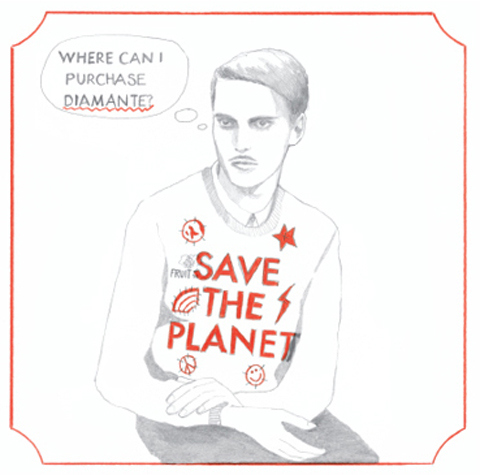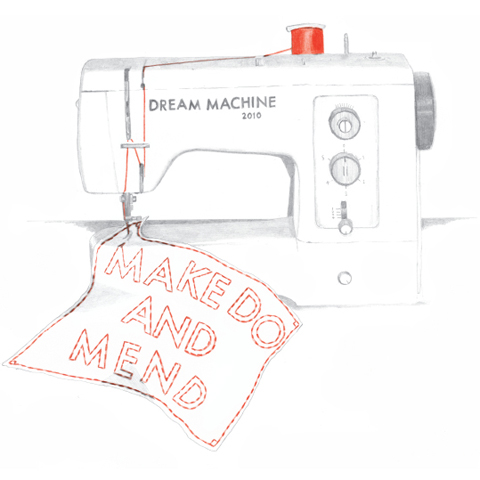Illustrations by Zoe Barker
Sustainable Fashion, what does that mean? This was the question posed by Vanessa Friedman at the beginning of London Fashion Week’s Estethica guide. I approached LFW with a fair amount of scepticism. Despite wearing my UK Press Pass with the secret pride reserved for a total LFW novice like moi, bien sûr, and being in total awe of how much work our fashion ed Rachael, all the writers, photographers and illustrators had put into it all, I was hesitant.

Is fashion that great? One part of me thinks it’s essential to be constantly re-inventing and changing things, challenging what we take as a given and celebrating new creativity. And that fashion is another form of individual and social expression and even a tool for rebellion against restrictive archaic norms. But another part thinks that the fashion industry is responsible for an attitude that waste is OK as long as it provides a fleeting moment of self-centred happiness, and that we need to be constantly re-inventing the way we look. That fashion stands for endless buying, and the sanctioning of a kind of mass egomania. Alternatively, it means the production of things that are so well made they will last forever, but which are destined for an elite few whose monthly wages allow for it. So should this kind of thinking now be greened and made sustainable? Hmm…it doesn’t really appeal. And, while it admittedly takes a very narrow view of fashion, I loved Tanya Gold’s blunt, honest piece on ‘Why I Hate Fashion’ in The Guardian a few weeks ago. It does raise the question though: what does fashion, let alone sustainable fashion, even mean?
The concept of eco-fashion has always grated a bit, probably because my purse-strings don’t stretch so far (and of course never will do if I try to pursue writing as a career), but also because, at the upmarket end, it smacks of elitism and the opportunity to not only redeem yourself, but to then preach to others about how fantastic it makes you feel. Oh great, we can still carry on buying loads of expensive crap, because now it’s ‘organic’. Dear 90% of the planet, don’t worry! We will save you with our brand new ethical consumer habits! One fabulous certified organic fair-trade handbag at a time. It’s a typical voting with our credit cards kind of scenario, and it leaves those that can’t or don’t want to buy into the consumer ‘revolution’ (i.e. the vast majority of human beings on the planet) somewhat disenfranchised.
Once upon a time I used to make and wear almost all my own clothes. Charity shops on the high street near my school were my Topshop. My thinking was, I can spend a fiver and get lots of unexpected random things from the clearance rail of a charity shop, have some fun cutting it up and sewing it back together, and wear it with pride even if it’s falling apart, or spend £30 (which represented a whole day’s work in my Saturday job) in Topshop on something made in a sweatshop and that there are 20 identical versions of on the rail. A battered old Singer sewing machine helped me to produce most of my 6th form wardrobe, and, admittedly, a trail of fashion disasters whose only purpose became household rags.
I loved sitting at my sewing machine, attacking things with scissors, making bags out of skirts, skirts out of dresses, dresses out of huge shirts, going to the bargain haberdashery stalls at markets and hunting out what I needed that week. None of my creations were planned or measured, so it was hardly difficult! My sister and I put on a crazy fashion show at school which consisted of t-shirts with massive holes, paint splodges, mini skirts made of tracksuit bottoms, dresses made of old saris, ripped tights, and asked our friends, our catwalk models, to just dance to The Hives album we decided would be the full volume soundtrack to our show.
Our music teacher loved it, but I think the rest of the Senior Management Team would have preferred something a little more conservative. Only recently have I discovered that what I was doing could technically have been called upcycling, and that an increasing amount of designers are turning to it, with much greater skill and expertise than I had when I was 16, clearly. There were a few designers using upcycling that I really liked in the Estethica rooms. Notably Goodone who collaborate with Heba Women’s Project, and Lu Flux. Kudos also to Izzy Lane with their beautiful wares and their strong animal welfare message (they use wool from sheep that have been saved from slaughter), extending our concept of equality beyond the human realm.
Britain generates 1 million tonnes of textile landfill every year. Textile recycling companies like LMB in London and I and J Cohen in Manchester collect between 170 and 200 tonnes of unwanted clothes and materials each week! Humans have been ‘upcycling’ since the beginning of time, making do with what’s there and improving it if need be. But it’s only recently that we have the opportunity and need to deal with quite such vast mountains of junk. So having it officially adopted as a fashion movement is a no-brainer, really. Companies will soon be jumping on the bandwagon left right and centre trying to prove that they have included a scrap of reclaimed materials in their collections.
This is why it is important, in my opinion, to remember that this should be an opportunity to move away from normal fashion consumption. One of the reasons I like upcycling is that it means we can be involved in the evolution and life cycle of an object rather than just being consumers of it. The designer also gains a much broader significance. This should definitely be an opportunity to get more people interested and able to partake in the production of clothes, rather than purely their ‘consumption.’
Upcycling, on a small scale, isn’t an expensive venture. Hopefully more people will be inspired to stop looking at products as a finished thing that can be bought, used, then thrown away, whether by DIYing and attending workshops, or supporting designers for whom upcycling and recycling is a central issue. Upcycled fashion is ecologically and socially conscious without being righteous or moralistic. It challenges our perception of waste and shows how it can be transformed into something beautiful and useful. It is a way to reclaim ‘fashion’, rethink our notion of eco-fashion, and bring ecology into yet more creative hands, rather than leaving it as an issue to debate over while scientists, politicians and lobbyists bicker it out to infinity. We don’t have to go far to find these ecological textiles, they are in recycling centres, charity shops, and our wardrobes and cost next to nothing. And second hand sewing machines aren’t hard to find either. For now though, I leave fashion writing well and truly to the pros.

